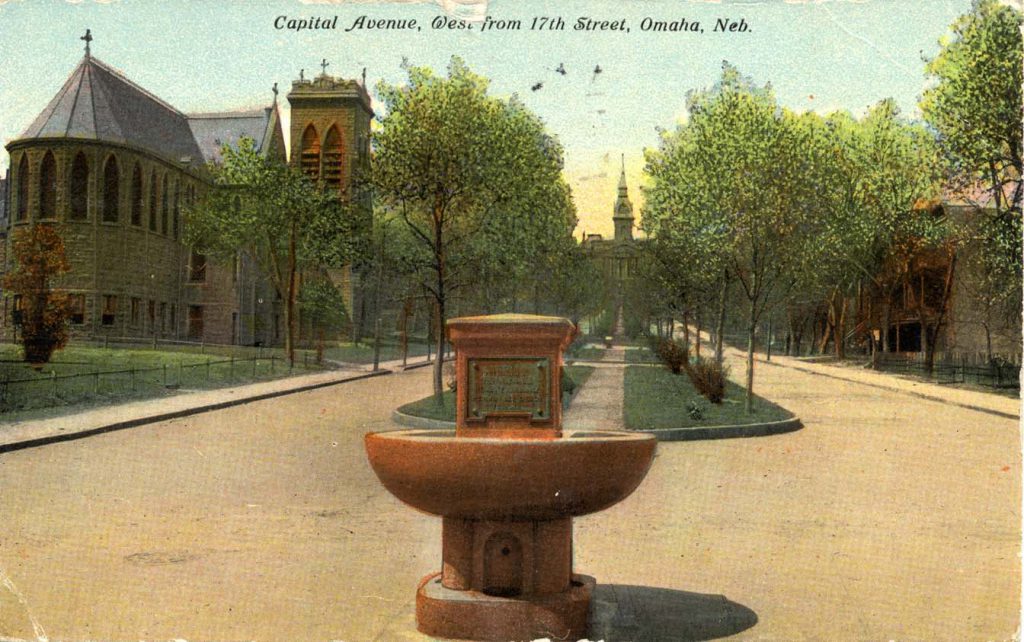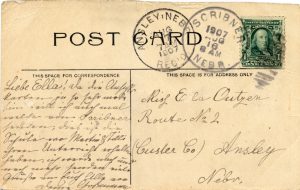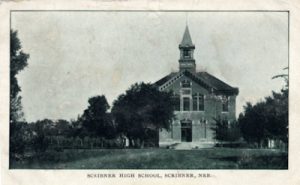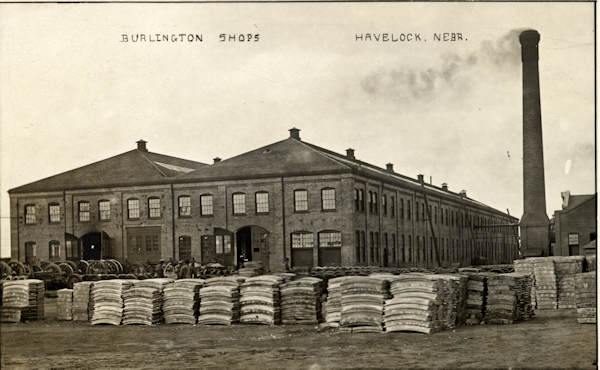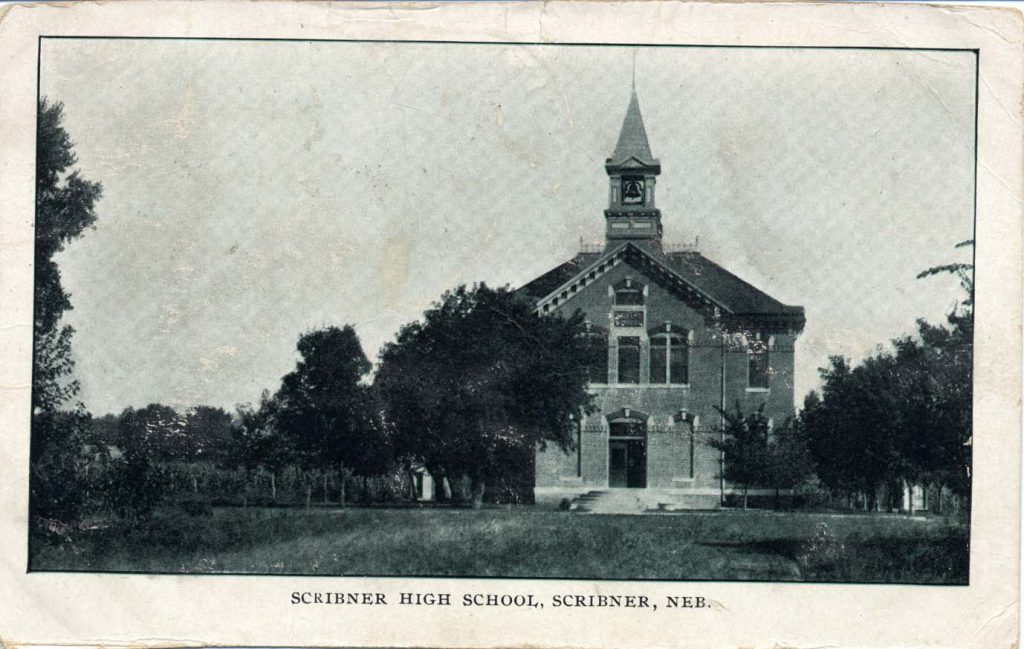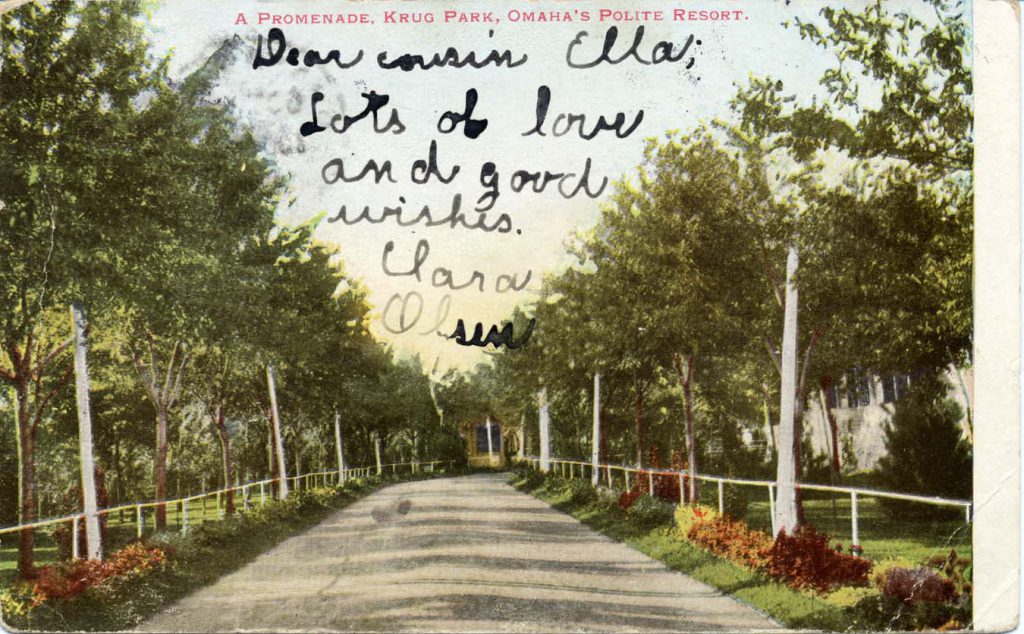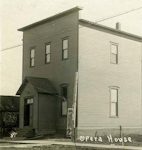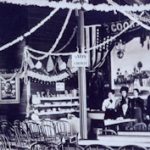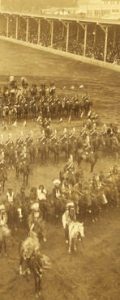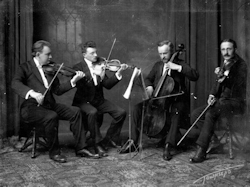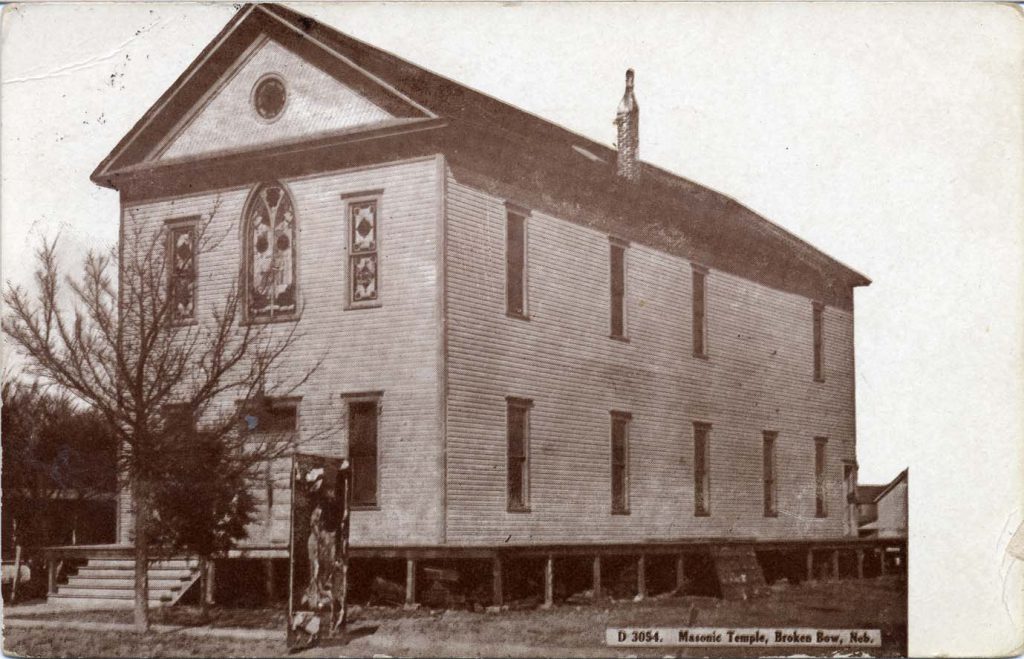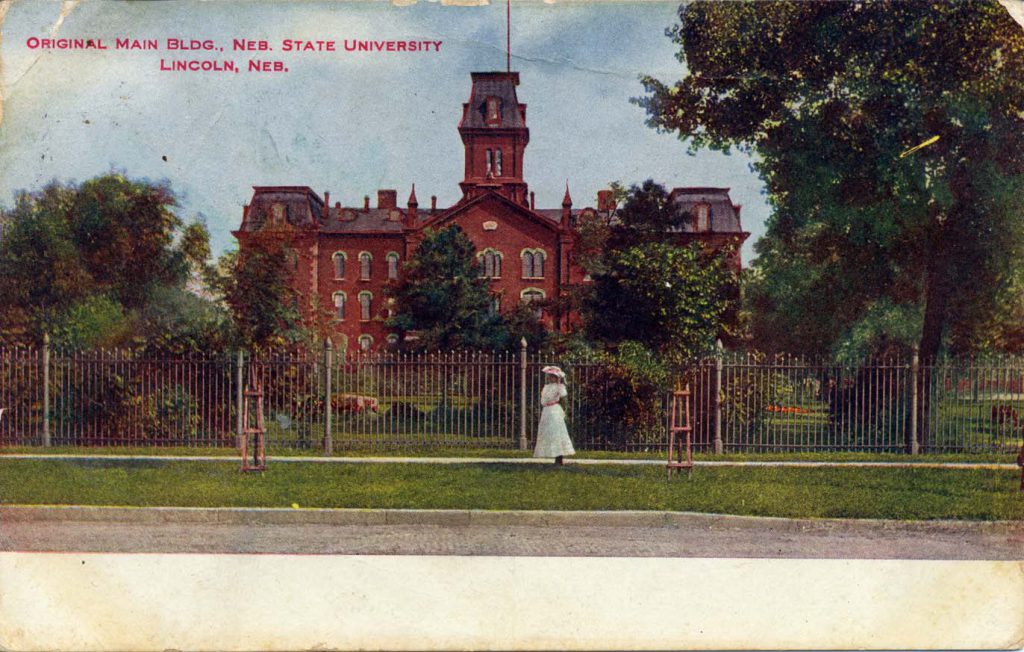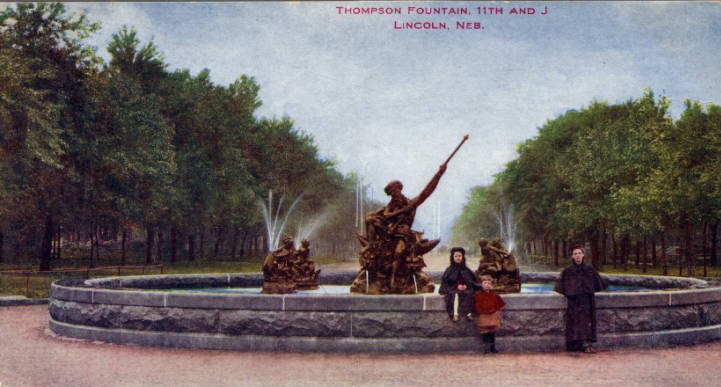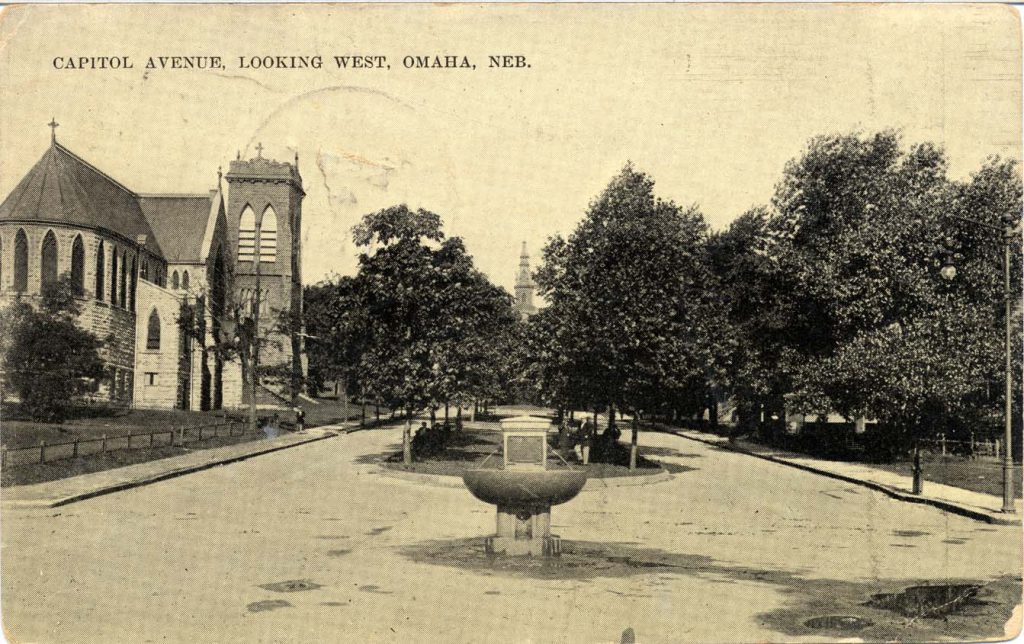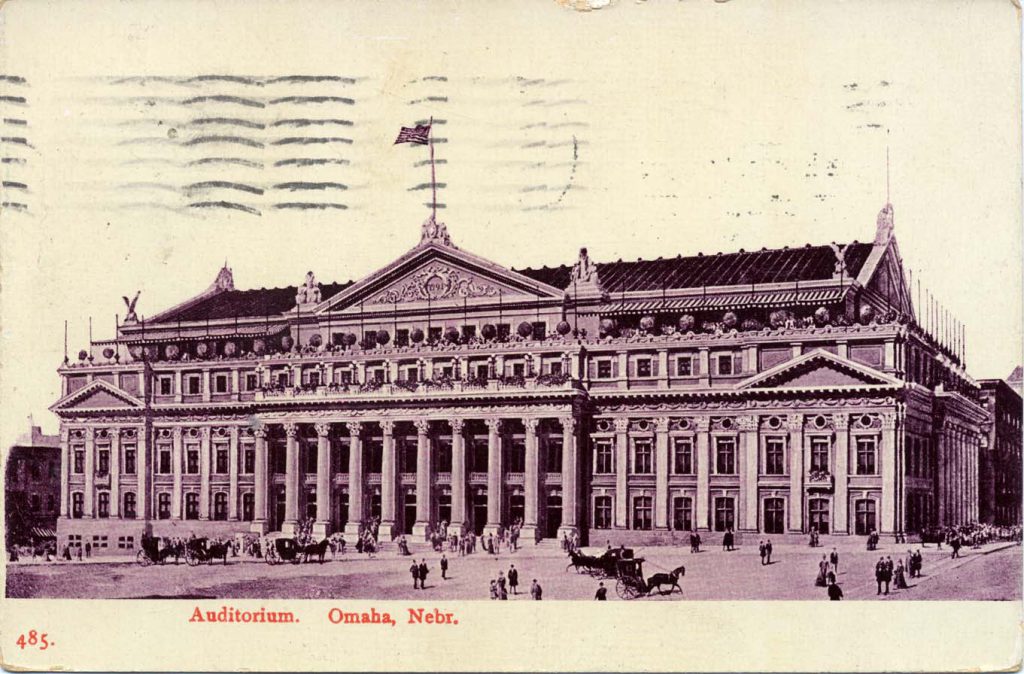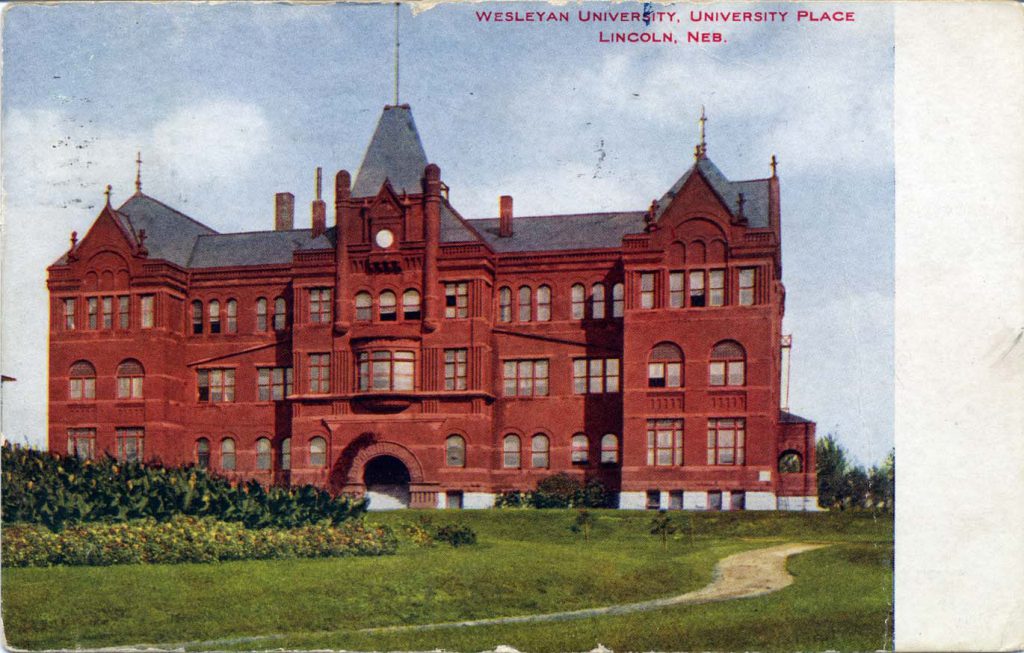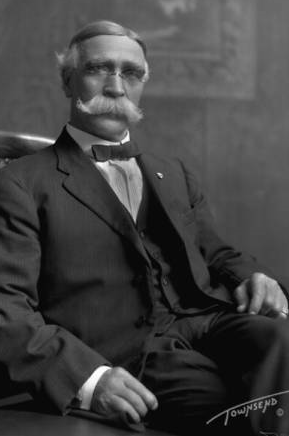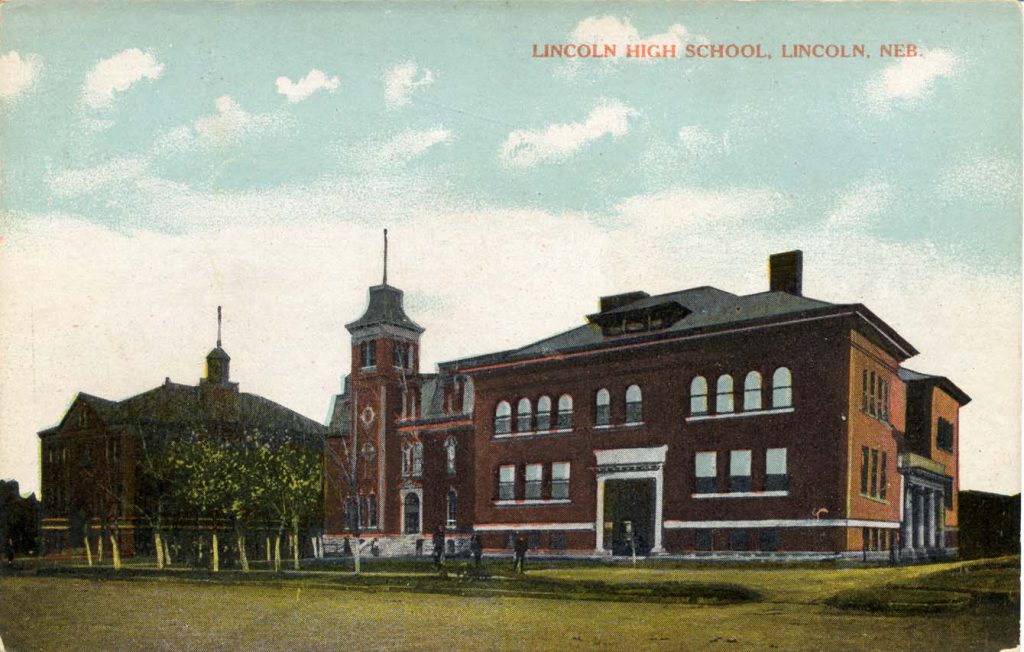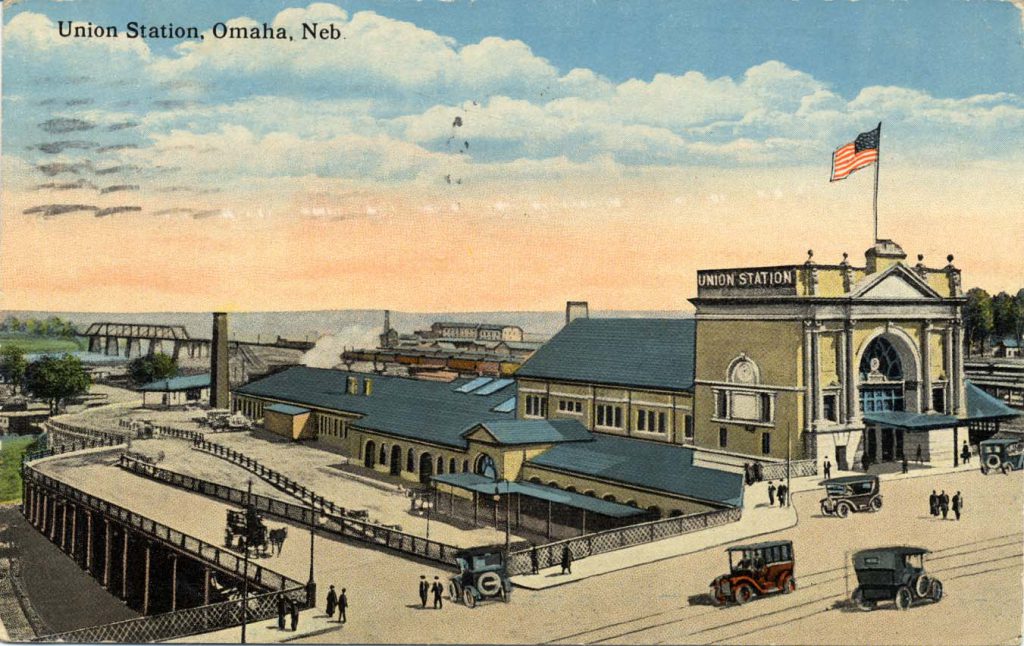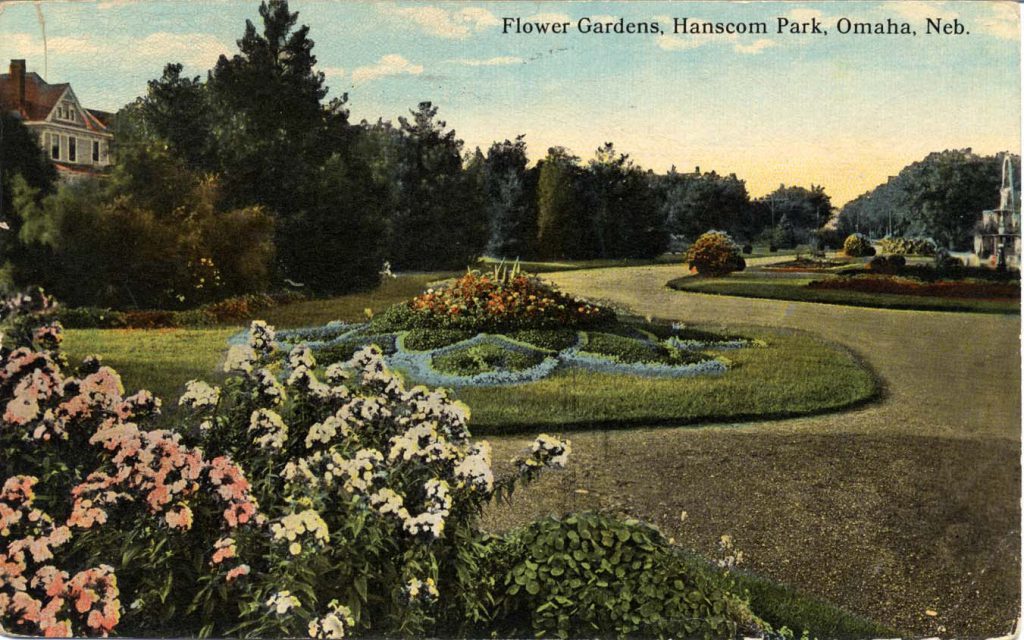Search the Blog
Categories
- Books & Reading
- Broadband Buzz
- Census
- Education & Training
- General
- Grants
- Information Resources
- Library Management
- Nebraska Center for the Book
- Nebraska Libraries on the Web
- Nebraska Memories
- Now hiring @ your library
- Preservation
- Pretty Sweet Tech
- Programming
- Public Library Boards of Trustees
- Public Relations
- Talking Book & Braille Service (TBBS)
- Technology
- Uncategorized
- What's Up Doc / Govdocs
- Youth Services
Archives
Subscribe
Category Archives: Nebraska Memories
Throwback Thursday: Capital Avenue, Omaha, Nebraska
Picture postcard of Capital Avenue, West from 17th Street, Omaha, Nebraska. Approximate date early 1900s.
Posted in General, Nebraska Memories
Leave a comment
Just a Brief Note . . . .
Before I became a librarian, I worked as a researcher for a consulting firm. Most of my work focused on clients who were involved in environmentally-based litigation. While I mainly read typed or printed government records, occasionally a client asked me to look at older documents – shipping manifests, diaries and correspondence – stuff that was written in longhand! As you can imagine, I became proficient at reading nineteenth-century handwriting. Recently, I had a chance to put those skills to the test when a postcard written in German crossed my desk.
For the record, I cannot read or speak German. Before I asked a retired professor from Nebraska Wesleyan to translate, I attempted to do so using Google Translate. I realized pretty quickly the handwriting was not the nineteenth-century script I had dealt with previously. For starters, it may incorporate both German and English cursive.
The script appears to an older form of German-language handwriting known as Kurrent. Kurrent is based on late medieval cursive and German cursive. It was used heavily in Middle to High German-speaking regions during the nineteenth and early-twentieth centuries. Like any written script, Kurrent characters vary in shape and form, making it difficult to interpret.
This particular letter was written to a young woman, named Ella, by her grandmother. In the letter, Ella’s “Granny” mentions two people known to Ella, who had taught at Scribner High School. Although brief, Granny shares some family history, as well as let Ella know that she’s not far from her thoughts.
This letter also tells us that Ella reads, and most likely speaks German. Based on the fact that Kurrent was used in specific places, we have an idea of where Granny lived before moving to Nebraska. Additionally, Scribner wasn’t settled until the 1870s, when the railroad arrived. The high school featured in this image, wasn’t built until 1885. Granny most likely was a relatively recent arrival in eastern Nebraska.
Brief notes like this one can share a lot of information. They drop hints about the writer’s and the reader’s backgrounds and relationships. Postcards offer us a glimpse into the private worlds of people like Granny and Ella.
Visit Nebraska Memories to search for or browse through many more historical images digitized from photographs, negatives, postcards, maps, lantern slides, books and other materials.
Nebraska Memories is a cooperative project to digitize Nebraska-related historical and cultural heritage materials and make them available to researchers of all ages via the Internet. Nebraska Memories is brought to you by the Nebraska Library Commission. If your institution is interested in participating in Nebraska Memories, see http://nlc.nebraska.gov/nebraskamemories/participation.aspx.For more information, contact Devra Dragos, Technology & Access Services Director.
Posted in Nebraska Memories
2 Comments
What are they?
Every time I see this image of the Burlington Shops in Nebraska Memories, I wonder what the gray things are piled up in front of the buildings.
Before asking for help identifying the items I had to do my own research. I’ve learned a lot about the Burlington Shops. I still don’t know what those items are but I have some better guesses now. Before I share my guesses and ask for your help, let me tell you what I’ve learned about the Burlington Shops in Havelock.
The book Lincoln: The Capital City and Lancaster County, Nebraska, Volume 1 (1916) provides a nice history of the town and the shops. The town of Havelock was incorporated on May 6, 1893. It was located about four 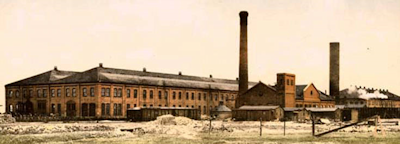 miles northeast of downtown Lincoln. Around the same time, Burlington decided to locate a repair and manufacturing shop in Havelock. Work on the first building started in June of 1890. A blacksmith shop, boiler shop and a new shop building were added a few years later. The next large expansion came 1910.
miles northeast of downtown Lincoln. Around the same time, Burlington decided to locate a repair and manufacturing shop in Havelock. Work on the first building started in June of 1890. A blacksmith shop, boiler shop and a new shop building were added a few years later. The next large expansion came 1910.
I was surprised by the amount of information I was able to find about the shops and expansion that took place around 1910. I found two journals articles published in 1911 that included detailed information about the Burlington Shops. At first glance, the articles may appear to be identical but they are slightly different. They contain too much information for me to include in this post but below are links to the articles along with few highlights.
- New Locomotive Repair Shops at Havelock, Neb. American Engineer and Railroad Journal, Volume 85
- Havelock Shops, Chicago, Burlington & Quincy R. R. Railway Master Mechanic, Volume 35
Here are a few highlights from these articles.
 Both articles provide detailed drawings of the property that includes the location and dimensions of every building. I found it fun to compare the map to a current bird’s eye view of the shops. Many of the builds are still being used today.
Both articles provide detailed drawings of the property that includes the location and dimensions of every building. I found it fun to compare the map to a current bird’s eye view of the shops. Many of the builds are still being used today.- The newly built storehouse is 80 ft. wide, 500 ft. long, and three stories high. It is surrounded on three sides by a 16 ft. wide platform.
- On the west end of the storehouse, 100 ft. of space on the first and second floors was designed as office space. On the first floor were “quarters of the superintendent of shops and the storekeeper. On the second floor are the stationer, medical examiner with emergency hospital fully equipped, telephone exchange, space for apprentice school and meeting room.”
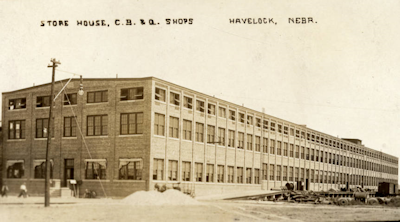
- The windows in the storehouse were designed to work with the material cases that would be stored in the building. “The material cases are 5 feet wide at the bottom and are separated by space of the same width. This arrangement gives a case spacing of 10 feet center to center and 7 feet of window between two adjacent cases, the tops of which are three feet wide.”
While both of these journal articles provided me with a ton of information, I still didn’t have any good guess about the objects in the photo. I thought they might be made out of cement because if you look at the bottom of a few of the stacks you can see that a few of them have broken. 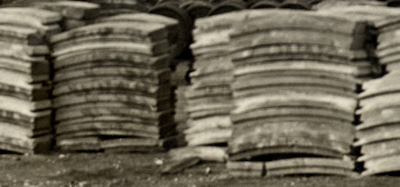
The article A Modern Concrete Slab and Pile Plant appeared in the 1921 issue of Railway Track and Structures, Volume 17 confirms that there was a concrete plant at the Havelock shops. The article listed some of the items manufactured at the Havelock Shops. “In addition to the concrete slabs and piles, the concrete plant is equipped to manufacture concrete fence posts, platform curbs, hog troughs and some miscellaneous items.” Included with the article was a picture of concrete curb units but they do not match the items in the picture.
Now that you know a bit more about the Burlington Shops at Havelock, what do you think the items are piled in front of the boiler shop? If you haven’t already done so, take a minute and go view the image on the Nebraska Memories website. You can use the zoom function to get a better view.
What do you think they are? As you can see, there are a few different items. I can pick out three different styles for sure.
 At the far left, you can see three small piles. I think they are flat but they do have slight curve to them.
At the far left, you can see three small piles. I think they are flat but they do have slight curve to them.
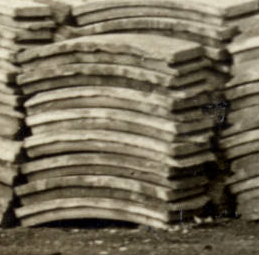 In the middle of the picture are items that have a slight arch to them. If you look at the bottom of the piles, you can see a significant gap between the middle of the items and the ground. As I mentioned before a few of them have broken. Do you think these and the first items are both curbs used on curves?
In the middle of the picture are items that have a slight arch to them. If you look at the bottom of the piles, you can see a significant gap between the middle of the items and the ground. As I mentioned before a few of them have broken. Do you think these and the first items are both curbs used on curves?
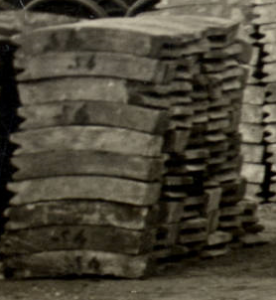 The items at the far right are much shorter. I think they have a slight arch to them. As I was looking at the picture of the roundhouse, I was wondering if these pieces could be used to line the turntable.
The items at the far right are much shorter. I think they have a slight arch to them. As I was looking at the picture of the roundhouse, I was wondering if these pieces could be used to line the turntable.
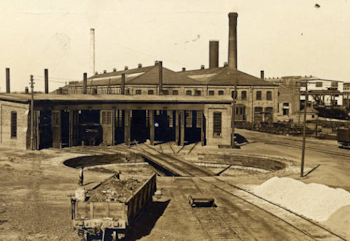 Do you agree with my guesses or am I completely off track? Are these pieces used in assembling a train engine? Leave me a comment and let me know what you think they are.
Do you agree with my guesses or am I completely off track? Are these pieces used in assembling a train engine? Leave me a comment and let me know what you think they are.
If you are interested in the Burlington shops, I found two additional historical journals articles that I read but didn’t reference in this post. I thought you might enjoy reading them.
- The Employment of Women in Railroad Shops
Railway Age Gazette, Volume 63 – 1917 - The Concrete Fence Post Factory of the C. B. & Q. R. R. Co., Havelock Neb.
Concrete-cement Age, Volume 6 – 1915
Visit Nebraska Memories to search for or browse through many more historical images digitized from photographs, negatives, postcards, maps, lantern slides, books and other materials.
Nebraska Memories is a cooperative project to digitize Nebraska-related historical and cultural heritage materials and make them available to researchers of all ages via the Internet. Nebraska Memories is brought to you by the Nebraska Library Commission. If your institution is interested in participating in Nebraska Memories, see http://nlc.nebraska.gov/nebraskamemories/participation.aspx for more information, contact Devra Dragos, Technology & Access Services Director.
Posted in Nebraska Memories
Leave a comment
The Luck of the Irish
At 32,599 square miles, the island that contains the Republic of Ireland and Northern Ireland has just over two-fifths the area of the state of Nebraska. However, it has made a huge impact on the world through the immigration of its people to other places. While the largest diaspora occurred during the potato famines of the 1840s, many Irish continued to move to the United States throughout the rest of the nineteenth century and the early twentieth century. A fair number of them came to Nebraska.
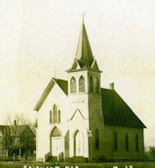 According to Nebraska Moments by Donald R. Hickey, et al., the very first church built in Nebraska Territory was a Catholic church to serve the Irish population in 1856. Another church purported to have been built for residents of Irish descent some 26 years later was the St. James Catholic Church of Fairmont at left (Fairmont Public Library Collection). After Germans (a mix of Catholic and Protestant faiths) and Swedes (generally Lutheran), the Irish made up the third largest ethnic group of immigrants to Nebraska.
According to Nebraska Moments by Donald R. Hickey, et al., the very first church built in Nebraska Territory was a Catholic church to serve the Irish population in 1856. Another church purported to have been built for residents of Irish descent some 26 years later was the St. James Catholic Church of Fairmont at left (Fairmont Public Library Collection). After Germans (a mix of Catholic and Protestant faiths) and Swedes (generally Lutheran), the Irish made up the third largest ethnic group of immigrants to Nebraska.
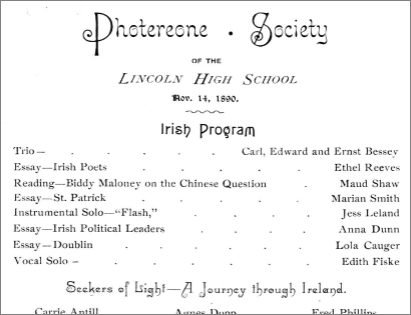 O’Neill, which has been proclaimed “The Irish Capital of Nebraska,” was named for John O’Neill, who helped establish several towns in Nebraska with Irish settlers. O’Neill, a U.S. Civil War veteran, had worked for “Home Rule” in Ireland, trying to push the British out. Some years later in 1890 that topic was raised in a program at Lincoln High School by the Photereone Society (Polley Music Library Collection). Along with a mixture of music and dramatics, students debated Irish Home Rule and discussed the issue of Chinese immigration. In two years the Chinese Exclusion Act that suspended Chinese laborer immigration to the United States was due to expire; the Act was renewed in 1892. Some people also wanted to restrict the immigration of other ethnic groups, including the Irish.
O’Neill, which has been proclaimed “The Irish Capital of Nebraska,” was named for John O’Neill, who helped establish several towns in Nebraska with Irish settlers. O’Neill, a U.S. Civil War veteran, had worked for “Home Rule” in Ireland, trying to push the British out. Some years later in 1890 that topic was raised in a program at Lincoln High School by the Photereone Society (Polley Music Library Collection). Along with a mixture of music and dramatics, students debated Irish Home Rule and discussed the issue of Chinese immigration. In two years the Chinese Exclusion Act that suspended Chinese laborer immigration to the United States was due to expire; the Act was renewed in 1892. Some people also wanted to restrict the immigration of other ethnic groups, including the Irish.
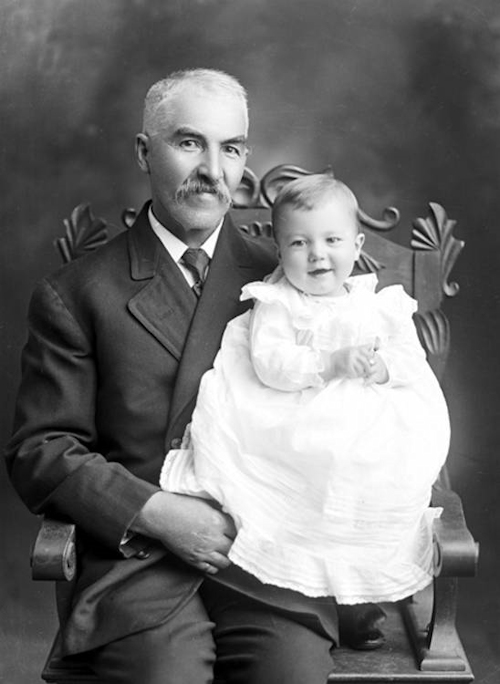
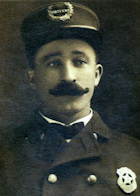 The Irish worked at a variety of jobs in Nebraska. William McGaffin, above with his son Wesley (Butler County Gallery), and his first wife Margery emigrated to the United States in the late 1860s. After spending some years in New York, the McGaffins moved to Butler County, Nebraska in 1885. McGaffin published the Bellwood Gazette that year and ran the paper into the 1920s. Joseph Haney, at right (The Lincoln Police Department Collection), was a baby when his family emigrated in 1881. From age 16-20, Haney drove a police wagon for the Lincoln police department. Another Irishman, Captain William T. B. Ireland who was born in New York, served with the Lincoln Police Department for over 20 years.
The Irish worked at a variety of jobs in Nebraska. William McGaffin, above with his son Wesley (Butler County Gallery), and his first wife Margery emigrated to the United States in the late 1860s. After spending some years in New York, the McGaffins moved to Butler County, Nebraska in 1885. McGaffin published the Bellwood Gazette that year and ran the paper into the 1920s. Joseph Haney, at right (The Lincoln Police Department Collection), was a baby when his family emigrated in 1881. From age 16-20, Haney drove a police wagon for the Lincoln police department. Another Irishman, Captain William T. B. Ireland who was born in New York, served with the Lincoln Police Department for over 20 years.
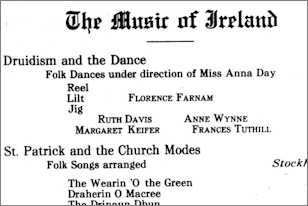 Whether or not you have descended from those earlier Irish immigrants, you might have enjoyed the St. Patrick’s Day musicale at the Temple Theatre in 1913 with song and dance (Polley Music Library Collection). I plan to enjoy some Irish dancing myself tonight across the street in the newer performing arts center. Enjoy your St. Patrick’s Day!
Whether or not you have descended from those earlier Irish immigrants, you might have enjoyed the St. Patrick’s Day musicale at the Temple Theatre in 1913 with song and dance (Polley Music Library Collection). I plan to enjoy some Irish dancing myself tonight across the street in the newer performing arts center. Enjoy your St. Patrick’s Day!
Visit Nebraska Memories to search for or browse through many more historical images digitized from photographs, negatives, postcards, maps, lantern slides, books and other materials.
Nebraska Memories is a cooperative project to digitize Nebraska-related historical and cultural heritage materials and make them available to researchers of all ages via the Internet. Nebraska Memories is brought to you by the Nebraska Library Commission. If your institution is interested in participating in Nebraska Memories, see http://nlc.nebraska.gov/nebraskamemories/participation.aspx for more information, contact Devra Dragos, Technology & Access Services Director.
Posted in Nebraska Memories
Leave a comment
Throwback Thursday: Promenade Krog Park, Omaha, Nebraska
Postcard of Promenade Krog Park, Omaha’s Polite Resort, Omaha, Nebraska. Approximate date early 1900’s.
Posted in General, Nebraska Memories
Leave a comment
Good Times in Nebraska
When people think of places like Nebraska, and the American West in general, they often assume that residents have little to no access to cultural institutions. That is, no libraries, opera houses, theaters, art museums or symphonies. Those of us who live in the West, know this to be otherwise. In fact, nineteenth century mining communities hosted traveling acting troupe or minstrel shows. Other early towns built opera houses and theaters, while some opened small libraries.
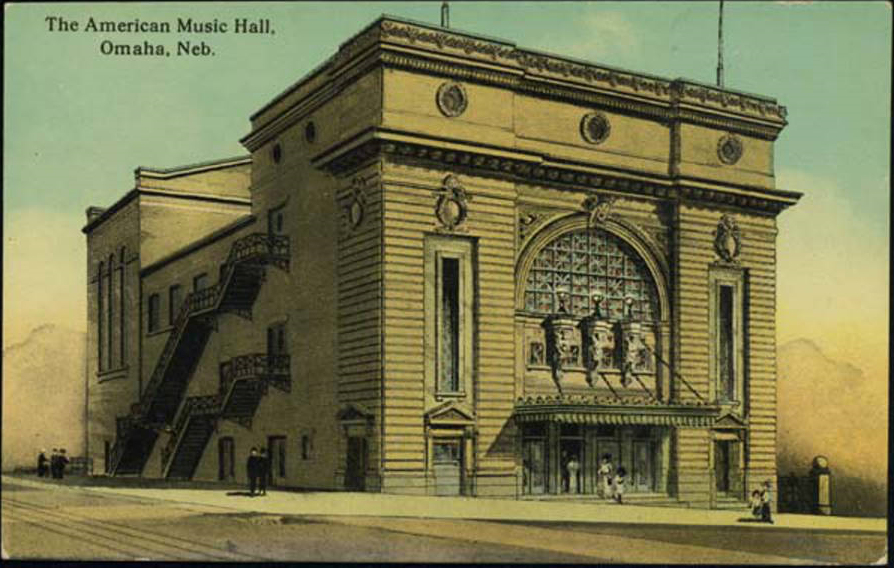
With its large population, Omaha was home to numerous theaters, such as the American Music Hall and the Orpheum Theater.
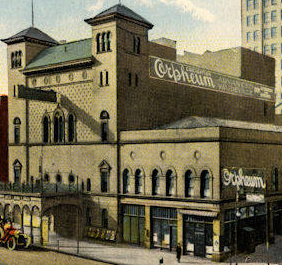
Theaters and other entertainment venues could be found in smaller communities as well. Opera houses, for example, could be found in Valley and Papillion. They may not have been the most beautiful of buildings, but they provided stages for more than a few talented people. More importantly, opera productions allowed people with a brief respite from the rigors of prairie life.
Additionally, Nebraska was home to more than few musical groups. Composed of local musicians, these groups enabled participants to hone their talents while providing entertainment for others. For some musicians, particularly those who immigrated from outside the United States, music may have not only connected them to fellow immigrants, but linked them to their former homes as well.
If the opera or a musical gathering didn’t provide enough entertainment, people could attend Buffalo Bill’s Wild West Show when it roared into the state. Perhaps not high culture, but entertaining!
Visit http://memories.nebraska.gov/ to search for or browse through many more historical images digitized from photographs, negatives, postcards, maps, lantern slides, books and other materials.
Nebraska Memories is a cooperative project to digitize Nebraska-related historical and cultural heritage materials and make them available to researchers of all ages via the Internet. Nebraska Memories is brought to you by the Nebraska Library Commission. If your institution is interested in participating in Nebraska Memories, see http://nlc.nebraska.gov/nebraskamemories/participation.aspx for more information, contact Devra Dragos, Technology & Access Services Director.
Posted in Nebraska Memories
Leave a comment
Dense Fog Leads to Head-on Collision
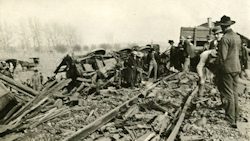 Sunday morning, November 22, 1908, two trains collided at Red Cloud killing two men. According to the article “Disastrous Wreck at Red Cloud” that appeared in the November 27, 1908 issue of The McCook Tribune, “two Burlington trains collided at the west end of the city stock yards at 6:55, doing great damage and killing two men and injuring one.”
Sunday morning, November 22, 1908, two trains collided at Red Cloud killing two men. According to the article “Disastrous Wreck at Red Cloud” that appeared in the November 27, 1908 issue of The McCook Tribune, “two Burlington trains collided at the west end of the city stock yards at 6:55, doing great damage and killing two men and injuring one.”
“The trains came together just beyond the yard limits, on a big curve, where there was a heavy fill, and the impact was so great that the engine 1225, pulling the extra from the west, was thrown from the track, as it struck 1182, 63’s engine, and was overturned and 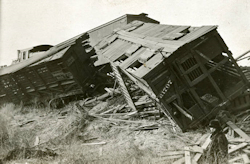 fell almost bottom side up, killing the two men as she went over. Train 63 was standing still, and the force of the collision was so great that five cars, the tender and engine were badly wrecked, and three cars and the engine on the stock extra were reduced to kindling wood. The wrecking train was ordered from McCook and reached here about 1:30, and the work of cleaning the track was commenced in earnest, and was finally finished at 5:40 p. m., so that trains could go over the track.”
fell almost bottom side up, killing the two men as she went over. Train 63 was standing still, and the force of the collision was so great that five cars, the tender and engine were badly wrecked, and three cars and the engine on the stock extra were reduced to kindling wood. The wrecking train was ordered from McCook and reached here about 1:30, and the work of cleaning the track was commenced in earnest, and was finally finished at 5:40 p. m., so that trains could go over the track.”
There are six photos of this deadly wreck in Nebraska Memories taken by L. E. Tait. Basic information is written on the edges of each photo but the newspaper article provides more details.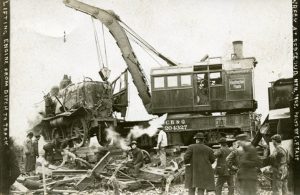 After reading the article, I think I was able to match the photos with the information provided in the newspaper article.
After reading the article, I think I was able to match the photos with the information provided in the newspaper article.
The photo labeled #1 shows the wrecking train, that came from McCook, lifting engine 1225. Engine 1225 was part of the stock train.
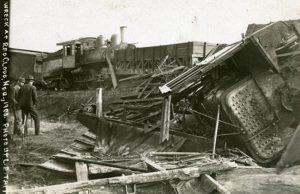 The photo labeled #2 shows two engines. I’m assuming the one at the top left of the photo is engine 1182. It was part of train No. 63. Along the right side of the photo is engine 1225. I know it’s somewhat hard to tell that this is an engine just by looking at this photo. If you compare the front end of the engine in photo #1 you can see that it matches the pile of metal on the ground.
The photo labeled #2 shows two engines. I’m assuming the one at the top left of the photo is engine 1182. It was part of train No. 63. Along the right side of the photo is engine 1225. I know it’s somewhat hard to tell that this is an engine just by looking at this photo. If you compare the front end of the engine in photo #1 you can see that it matches the pile of metal on the ground.
Photo #4 shows two men sitting on a pile of wreckage. Laying between them is a large axe. The man on the left is sitting on engine 1225, which is upside down.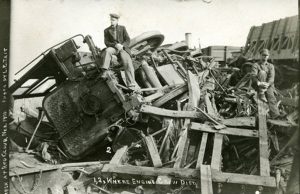 The paper said it “overturned and fell almost bottom side up, killing the two men as she went over.” The caption of the photo reads “1,2, Where Engine Crew Died”. If you look at the ground to the left and right of the engine, you will see the numbers 1 and 2 written on the picture. Killed in the accident were Engineer John W. Bartholoma and Fireman George Snoke. Short obituaries for both men can be found at the end of the newspaper article.
The paper said it “overturned and fell almost bottom side up, killing the two men as she went over.” The caption of the photo reads “1,2, Where Engine Crew Died”. If you look at the ground to the left and right of the engine, you will see the numbers 1 and 2 written on the picture. Killed in the accident were Engineer John W. Bartholoma and Fireman George Snoke. Short obituaries for both men can be found at the end of the newspaper article.
According to the newspaper article “The excitement was intense and more than 3,000 people visited the wreck, coming from Kansas and Nebraska towns for a radius of 20 miles, and most of them remained all day.” When I reading that line my first thought was that the newspaper article had to be exaggerating, that’s a lot of people. Looking closely at photo #6, I think the newspaper could be correct. Look at the huge groups of people on both sides of the track.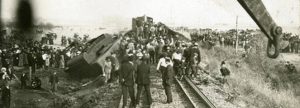
If you to read the complete newspaper article, you may have noticed that there was no reference to the dollar amount of damage caused by this wreck. While I was looking over the newspaper page that contained the article about the train wreck, I noticed the “Railroad News Items” along the left side of the page. Two items in this column relate to the wreck at Red Cloud.
- “The estimate of the total damages of last Sunday’s wreck is placed at near $20,000.”
- “The wrecking outfit came back from Red Cloud, Wednesday, and the engines – 1182 and 1225 – were started for Havelock, Thursday. The damage was estimated at over $4,000 on the two engines.”
Below the railroad news, you will find “Card of Thanks” from the Bartholoma and Snoke families.
I hope you enjoyed learning more about the C.B.&Q. (Chicago, Burlington & Quincy Railroad Company) train wreck at Red Cloud. Visit Nebraska Memories to search for or browse through many more historical images digitized from photographs, negatives, postcards, maps, lantern slides, books and other materials.
Nebraska Memories is a cooperative project to digitize Nebraska-related historical and cultural heritage materials and make them available to researchers of all ages via the Internet. Nebraska Memories is brought to you by the Nebraska Library Commission. If your institution is interested in participating in Nebraska Memories, see http://nlc.nebraska.gov/nebraskamemories/participation.aspx for more information, contact Devra Dragos, Technology & Access Services Director.
Posted in Nebraska Memories
Leave a comment
Throwback Thursday: Masonic Temple, Broken Bow, Nebraska.
Posted in General, Nebraska Memories
Leave a comment
Throwback Thursday: Original main building, Nebraska State University
Postcard of original main building, Nebraska State University, Lincoln, Nebraska. Approximate date early 1900’s.
Posted in General, Nebraska Memories
Leave a comment
To Serve at the Pleasure of the President
Among the positions appointed by a United States president are ambassadors to foreign countries. One former ambassador with Nebraska ties was David Eugene Thompson.
Born in Michigan, Thompson came to Lincoln by way of his work with the Burlington Railroad and made his mark in Lincoln during the 1890s and early 1900s. In addition to his work with the railroad, he was president of local gas and insurance companies.
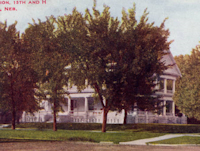
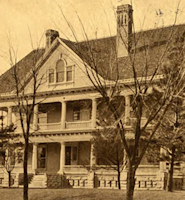 In 1892, Thompson and his wife, Jeannette, built a Neoclassical Revival-style two-and-a-half story house at 1445 H Street, seen in the postcards at left and right (Nebraska Library Commission Collection). The elegant residence contained several wood-paneled rooms on the first floor, six fireplaces, and a third floor ballroom. The Thompsons sold this house to the State of Nebraska in 1899 to serve as the first official Governor’s mansion. The sale included many of the furnishings. For more information about and photographs of the house, see James E. Potter, “The Governor’s House, the People’s House: Nebraska Governors’ Residences” Nebraska History 89 (2008):26-41.
In 1892, Thompson and his wife, Jeannette, built a Neoclassical Revival-style two-and-a-half story house at 1445 H Street, seen in the postcards at left and right (Nebraska Library Commission Collection). The elegant residence contained several wood-paneled rooms on the first floor, six fireplaces, and a third floor ballroom. The Thompsons sold this house to the State of Nebraska in 1899 to serve as the first official Governor’s mansion. The sale included many of the furnishings. For more information about and photographs of the house, see James E. Potter, “The Governor’s House, the People’s House: Nebraska Governors’ Residences” Nebraska History 89 (2008):26-41.
 The Thompsons next lived in the Lincoln Hotel seen at right (Townsend Studio Collection) and maintained rooms there as late as 1908. While living here, Thompson founded the Lincoln Daily Star newspaper, later the Lincoln Star, which finally merged with the Lincoln Journal in 1995 to become the current Lincoln Journal Star. He also became more involved in politics. President Theodore Roosevelt appointed Thompson as the “Envoy Extraordinary and Minister Plenipotentiary” to Brazil. Thompson took up his position as of April 1,1903. As of March 16, 1905, the position became “Ambassador Extraordinary and Plenipotentiary,” and the Thompsons remained in Brazil until November 1905. President Roosevelt next appointed Thompson as Ambassador to Mexico where he served from March 1906 to December 1909.
The Thompsons next lived in the Lincoln Hotel seen at right (Townsend Studio Collection) and maintained rooms there as late as 1908. While living here, Thompson founded the Lincoln Daily Star newspaper, later the Lincoln Star, which finally merged with the Lincoln Journal in 1995 to become the current Lincoln Journal Star. He also became more involved in politics. President Theodore Roosevelt appointed Thompson as the “Envoy Extraordinary and Minister Plenipotentiary” to Brazil. Thompson took up his position as of April 1,1903. As of March 16, 1905, the position became “Ambassador Extraordinary and Plenipotentiary,” and the Thompsons remained in Brazil until November 1905. President Roosevelt next appointed Thompson as Ambassador to Mexico where he served from March 1906 to December 1909.
The Thompsons remained in Mexico City where Thompson bought and managed the Pan-American Railway until his wife’s death in 1911. Mrs. Thompson was buried in the Wyuka Cemetery in Lincoln, and Thompson lived in Lincoln for a few more years before moving to California. After his death in 1942, Thompson was also buried in the Wyuka Cemetery.
At some point during the 1900s, the Thompsons gifted the city of Lincoln with the fountain seen below (Nebraska Library Commission Collection). Located at 11th and J Streets, the fountain remained a prominent feature of the capitol/university/downtown district until it was moved to Antelope Park which was developed in the late 1910s.
Visit Nebraska Memories to search for or browse through many more historical images digitized from photographs, negatives, postcards, maps, lantern slides, books and other materials.
Nebraska Memories is a cooperative project to digitize Nebraska-related historical and cultural heritage materials and make them available to researchers of all ages via the Internet. Nebraska Memories is brought to you by the Nebraska Library Commission. If your institution is interested in participating in Nebraska Memories, see http://nlc.nebraska.gov/nebraskamemories/participation.aspx for more information, contact Devra Dragos, Technology & Access Services Director.
Posted in Nebraska Memories
Leave a comment
Throwback Thursday: Capitol Avenue looking West, Omaha, Nebraska
Posted in General, Nebraska Memories
Leave a comment
Throwback Thursday: Auditorium, Omaha, Nebraska
Posted in General, Nebraska Memories
Leave a comment
Throwback Thursday: Wesleyan University
Postcard of Wesleyan University, University Place, Lincoln, Nebraska. Approximate date early 1900’s.
Posted in General, Nebraska Memories
Leave a comment
The Herpolsheimer Company
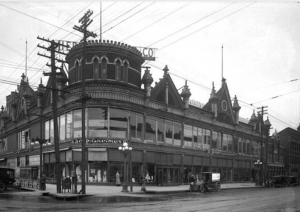 With Christmas just days away, many of us have been busy shopping for gifts. In the early days of Lincoln, residents had the choice of two department stores, Miller & Paine and Herpolsheimer’s. While Miller & Paine may be a name Nebraskan’s recognize I’m guessing most people don’t recognize the Herpolsheimer Company.
With Christmas just days away, many of us have been busy shopping for gifts. In the early days of Lincoln, residents had the choice of two department stores, Miller & Paine and Herpolsheimer’s. While Miller & Paine may be a name Nebraskan’s recognize I’m guessing most people don’t recognize the Herpolsheimer Company.
Henry Herpolsheimer first opened a dry goods store with Otto Mohrenstecher on O Street in downtown Lincoln. According to Lincoln historian Jim McKee, Henry built a new, 73,000-square-foot store at the corner of 12th and N Street in 1880. As you can see in the pictures of the building, there were large windows on the north side of the building. The store earned the nickname “The Daylight Store” because of the large windows and electric lights.
A window display of corsets was featured in the 1908 Dry Goods Reporter, Volume 38. According to the caption, the window was decorated by A. G. Sten. As a side note, if you are interested in photography note the article above the photo. It describes the steps you should take to get good photographs of display windows both during the day and at night. The night exposures could take up to thirty minutes.
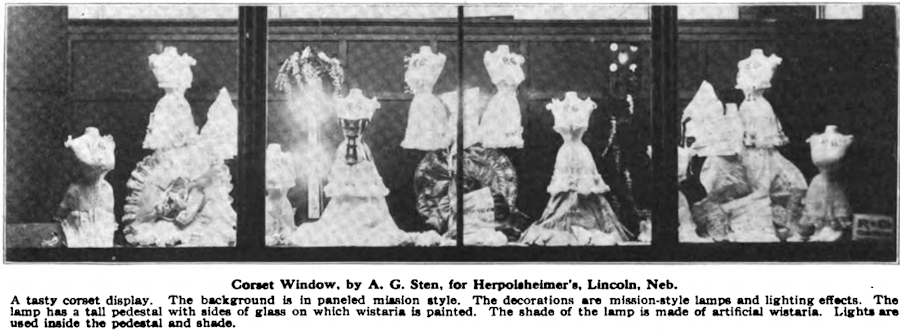
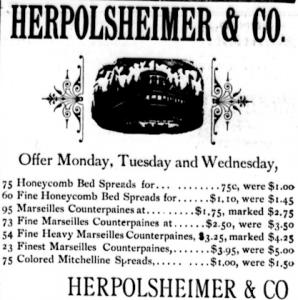 Herpolsheimer’s sold a wide variety of goods. An ad in the January 28, 1893 issue of the Capital City Courier listed bedspreads, spreads and counterpaines for sale. The prices ranged from seventy-five cents up to $5.00.
Herpolsheimer’s sold a wide variety of goods. An ad in the January 28, 1893 issue of the Capital City Courier listed bedspreads, spreads and counterpaines for sale. The prices ranged from seventy-five cents up to $5.00.
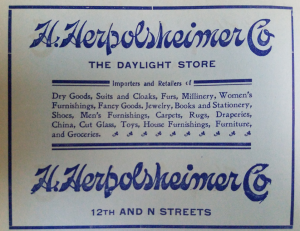 The ad for the H. Herpolsheimer Co. in the 1908 Lincoln Nebraska Directory (Jacob North & Company), lists many items for sale including dry goods, men’s and women’s furnishings, fancy goods, furs, toys and groceries.
The ad for the H. Herpolsheimer Co. in the 1908 Lincoln Nebraska Directory (Jacob North & Company), lists many items for sale including dry goods, men’s and women’s furnishings, fancy goods, furs, toys and groceries.
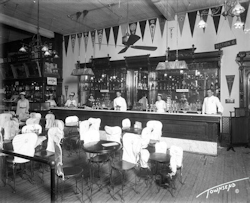 While I couldn’t find any information or advertisements for the soda fountain in the store, these 1914 photos show that they had one at that time. The signs on wall advertise items such as Dickinson’s Maple Mousse, a Mallow bitter sundae, Coca-Cola, and Vassar chocolates.
While I couldn’t find any information or advertisements for the soda fountain in the store, these 1914 photos show that they had one at that time. The signs on wall advertise items such as Dickinson’s Maple Mousse, a Mallow bitter sundae, Coca-Cola, and Vassar chocolates.
The Herpolsheimer Co. closed in 1931. I don’t know exactly when the building was torn down but by early 1939, a Firestone service station stood in its place at the corner of 12th and N. While there is still a Firestone station on that corner today, the original building was torn down and replaced in 1998.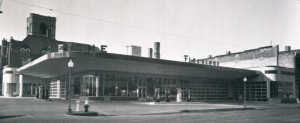
Visit Nebraska Memories to search for or browse through many more historical images digitized from photographs, negatives, postcards, maps, lantern slides, books and other materials.
Nebraska Memories is a cooperative project to digitize Nebraska-related historical and cultural heritage materials and make them available to researchers of all ages via the Internet. Nebraska Memories is brought to you by the Nebraska Library Commission. If your institution is interested in participating in Nebraska Memories, see http://nlc.nebraska.gov/nebraskamemories/participation.aspx for more information, contact Devra Dragos, Technology & Access Services Director.
Posted in General, Information Resources, Nebraska Memories, Technology
9 Comments
The Joys of Hunting Season in Nebraska
Before the advent of grocery stores, people produced much of their food. Although 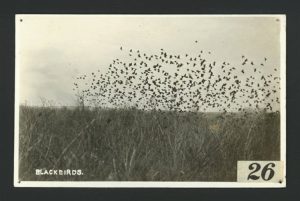 gardens and livestock supplied staples such as vegetables, milk and bacon, many settlers looked to hunting to supplement their diets as well as provide some much needed cash from the sale of pelts. Nebraska Memories not only features postcards and photographs birds and game, but of people posing with their rifles and the fruits of their labors as well.
gardens and livestock supplied staples such as vegetables, milk and bacon, many settlers looked to hunting to supplement their diets as well as provide some much needed cash from the sale of pelts. Nebraska Memories not only features postcards and photographs birds and game, but of people posing with their rifles and the fruits of their labors as well.
While the blackbirds featured in the above image may not have been intended for dinner, you can almost imagine a bird hunter eagerly awaiting their flight so that they might snag a bird or two to add to their collection. Take this photographic postcard from 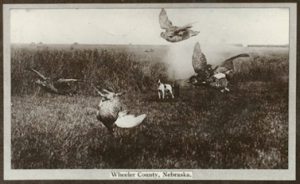 Wheeler County. It shows a hunter, with his trusty hunting dog, firing at several game birds. Chances are, these birds were destined for the family dinner table and the tail feathers used to decorate a hat.
Wheeler County. It shows a hunter, with his trusty hunting dog, firing at several game birds. Chances are, these birds were destined for the family dinner table and the tail feathers used to decorate a hat.
In addition to shooting game birds, Nebraskans hunted other animals, such as coyotes. After 1860, fur traders saw the value of coyote fur pelts increase from almost nothing to a few dollars or more per pelt. Coyote pelts could not be used as rugs, but they could be made into coats, jackets and hats. As such, they most likely became a source of income for many people. 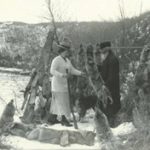 Additionally, ranchers disliked coyotes because they attacked sheep and cows. The couple featured in this postcard may have shot coyotes in order to harvest their fur or they may have been helping ranchers protect their livestock.
Additionally, ranchers disliked coyotes because they attacked sheep and cows. The couple featured in this postcard may have shot coyotes in order to harvest their fur or they may have been helping ranchers protect their livestock. 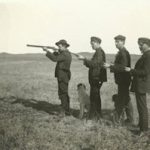
Not all photographs focus on potential targets or an expedition’s results. Some images are of the hunters themselves. This photographic postcard not only features four hunters posing with their shotguns, but three dogs can be glimpsed as well. While two of the three dogs are not visible clearly, the third one sits at his master’s feet, ready for action. Okay, maybe not. But bird hunters relied on dogs such as pointers, spaniels, setters, and retrievers to fetch downed birds. Despite their somewhat casual stances, I do not doubt the abilities of these hunters or their dogs.
Undoubtedly, hunting enabled many families to survive the often harsh and rugged Nebraska plains. A settler with a good shot gun could provide food, warm clothing or bedding in the form of fur pelts and cash from the sale of game or pelts. Hunting also helped protect livestock from predators like coyotes.
Visit Nebraska Memories to search for or browse through many more historical images digitized from photographs, negatives, postcards, maps, lantern slides, books and other materials.
Nebraska Memories is a cooperative project to digitize Nebraska-related historical and cultural heritage materials and make them available to researchers of all ages via the Internet. Nebraska Memories is brought to you by the Nebraska Library Commission. If your institution is interested in participating in Nebraska Memories, see http://nlc.nebraska.gov/nebraskamemories/participation.aspx for more information, contact Dragos Devra Technology & Access Services Director.
Posted in Nebraska Memories
Leave a comment
